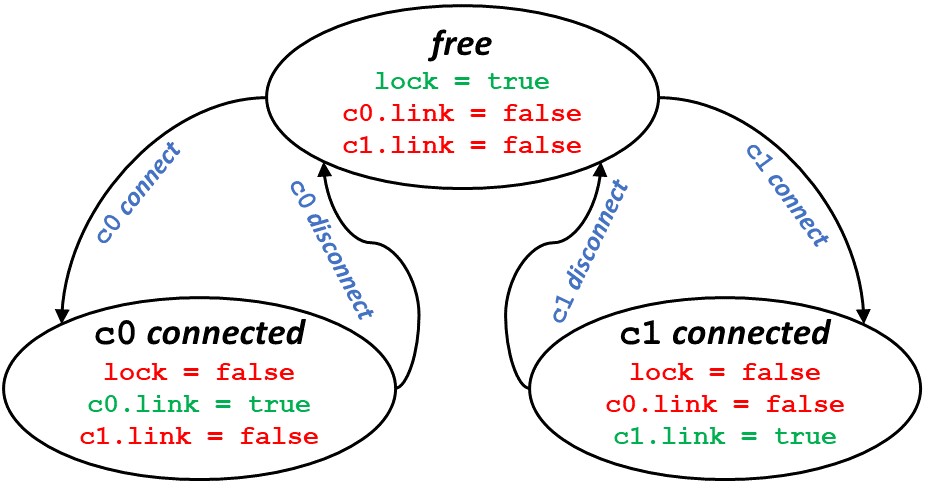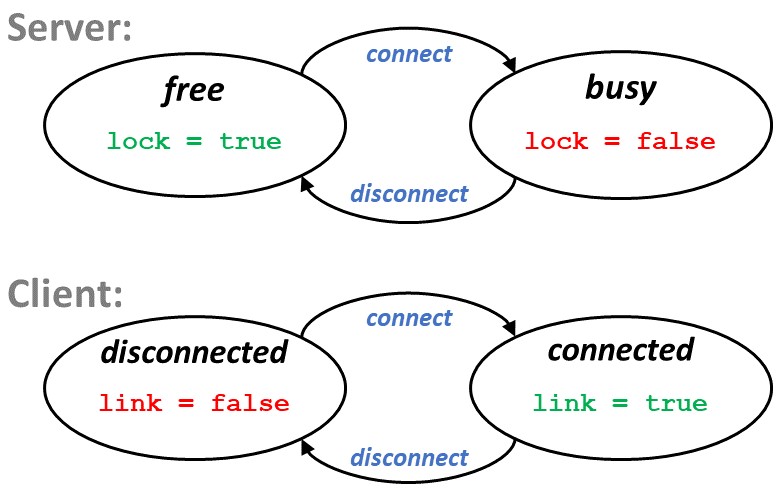
An introductory tutorial on protocol verification using Murphi.
We will verify a simple client server protocol -- lock server.
The smallest non-trivial instance has one server and two clients.
A client can perform two actions: connect and disconnect.
The server uses a lock to ensure that only one client is connected at a time.
Verification requires specifying the complete system as a state transition system.

Murphi description language:
Vars represent states; are of Type (can be user-defined).
Rule describes a transition; has pre-condition and action.
Let's specify our system using Murphi.
Var server_lock : boolean;
Var client0_link, client1_link : boolean;
StartState
Begin
server_lock := true;
client0_link := false;
client1_link := false;
End;
Rule "client 0 connect"
server_lock
==>
Begin
client0_link := true;
server_lock := false;
End;
Rule "client 1 connect"
server_lock
==>
Begin
client1_link := true;
server_lock := false;
End;
Rule "client 0 disconnect"
client0_link
==>
Begin
client0_link := false;
End;
Rule "client 1 disconnect"
client1_link
==>
Begin
client1_link := false;
End;
Compile and run:
$ ./mu lockserver.m
Code generated in file lockserver.C
$ make lockserver
g++ -DCATCH_DIV -Wno-write-strings -m32 -o lockserver lockserver.C -I../include -lm
$ ./lockserver
Result:
Deadlocked state found.
Protocol Deadlock: Specification is incorrect.
Murphi reports violation trace
$ ./lockserver -tv
The following is the error trace for the error:
Deadlocked state found.
Startstate Startstate 0 fired.
server_lock:true
client0_link:false
client1_link:false
----------
Rule client 1 connect fired.
server_lock:false
client1_link:true
----------
Rule client 1 disconnect fired.
The last state of the trace (in full) is:
server_lock:false
client0_link:false
client1_link:false
----------
End of the error trace.
Rule "client 0 disconnect"
client0_link
==>
Begin
client0_link := false;
server_lock := true;
End;
Rule "client 1 disconnect"
client1_link
==>
Begin
client1_link := false;
server_lock := true;
End;
Compile and run (output):
$ ./lockserver
Status:
No error found.
State Space Explored:
3 states, 4 rules fired in 0.10s.
Step 1(b): Protocol Correctness -- "only one client is connected at a time".
Invariant specifies a property that always holds.
Invariant "only one client at a time"
!server_lock & ((client0_link & !client1_link) | (!client0_link & client1_link))
Compile and run (output):
$ ./lockserver
Result:
Invariant "only one client at a time" failed.
$ ./lockserver -tv
The following is the error trace for the error:
Invariant "only one client at a time" failed.
Startstate Startstate 0 fired.
server_lock:true
client0_link:false
client1_link:false
----------
End of the error trace.
Invariant "only one client at a time"
server_lock | !server_lock & ((client0_link & !client1_link) | (!client0_link & client1_link))
OR write better invariant.
Invariant "only one client at a time"
!(client0_link & client1_link)
Compile and run (output):
$ ./lockserver
Status:
No error found.
State Space Explored:
3 states, 4 rules fired in 0.10s.
[source]

RuleSet applies rules using induction variables.
ForAll iterates over the range of induction variables.
[source]
Type
server_t : Record
lock : boolean;
End;
client_t : Record
link : boolean;
End;
client_n: 0..1;
Var
server : server_t;
client : Array[client_n] of client_t;
StartState
Begin
server.lock := true;
For c : client_n Do
client[c].link := false;
End;
End;
RuleSet c : client_n Do
Rule "client connect"
server.lock
==>
Begin
client[c].link := true;
server.lock := false;
End;
Rule "client disconnect"
client[c].link
==>
Begin
client[c].link := false;
server.lock := true;
End;
End;
Invariant "only one client at a time"
ForAll c : client_n Do
!(client[c].link & client[1-c].link)
End;
Compile and run (output):
$ ./lockserver -pr
Status:
No error found.
State Space Explored:
3 states, 4 rules fired in 0.10s.
Rules Information:
Fired 1 times - Rule "client disconnect, c:0"
Fired 1 times - Rule "client disconnect, c:1"
Fired 1 times - Rule "client connect, c:0"
Fired 1 times - Rule "client connect, c:1"
Invariant "only one client at a time"
ForAll c1 : client_n Do
ForAll c2 : client_n Do
client[c1].link & client[c2].link
->
c1 = c2
End
End;
Compile and run (output):
$ ./lockserver
Status:
No error found.
State Space Explored:
11 states, 20 rules fired in 0.10s.
Compile and run (output):
$ ./lockserver
State Space Explored:
101 states, 200 rules fired in 0.10s.
Compile and run (output):
$ ./lockserver
Error:
Internal Error: Too many active states.
ScalarSet is an unordered enumeration type that allows Murphi to leverage symmetry.
MultiSet is an unordered map with symmetry.
[source]
Const
numClient: 10;
Type
server_t : Record
lock : boolean;
End;
client_t : Record
link : boolean;
End;
client_n: ScalarSet(numClient);
Var
server : server_t;
client : Array[client_n] of client_t;
StartState
Begin
server.lock := true;
For c : client_n Do
client[c].link := false;
End;
End;
RuleSet c : client_n Do
Rule "client connect"
server.lock
==>
Begin
client[c].link := true;
server.lock := false;
End;
Rule "client disconnect"
client[c].link
==>
Begin
client[c].link := false;
server.lock := true;
End;
End;
Invariant "only one client at a time"
ForAll c1 : client_n Do
ForAll c2 : client_n Do
client[c1].link & client[c2].link
->
c1 = c2
End
End;
Compile and run (output):
$ ./lockserver
State Space Explored:
2 states, 11 rules fired in 0.10s.
Compile and run (output):
$ ./lockserver
State Space Explored:
2 states, 101 rules fired in 0.10s.
$ ./lockserver -nosym
State Space Explored:
101 states, 200 rules fired in 0.10s.
Compile and run (output):
$ ./lockserver
State Space Explored:
2 states, 1001 rules fired in 12.17s.